Bundesliga 2021-22 kicked off with a big clash between Borussia Monchengladbach and Bayern Munich on Friday night. Although the champions were clearly the favourites to win the game, Julian Nagelsmann could not secure his first victory in his debut game. At the Stadion im Borussia-Park, Bayern confronted a tough Adi Hütter team, and they might count themselves lucky for not conceding a second goal.
Since Nagelsmann came from RB Leipzig and while Hütter was deeply impacted by Ralf Ragninck and the “Stuttgart School”, the match was fascinating with so many details involved. This tactical analysis will cover the key tactics of both sides and explain why the adjustments were made.
Lineups
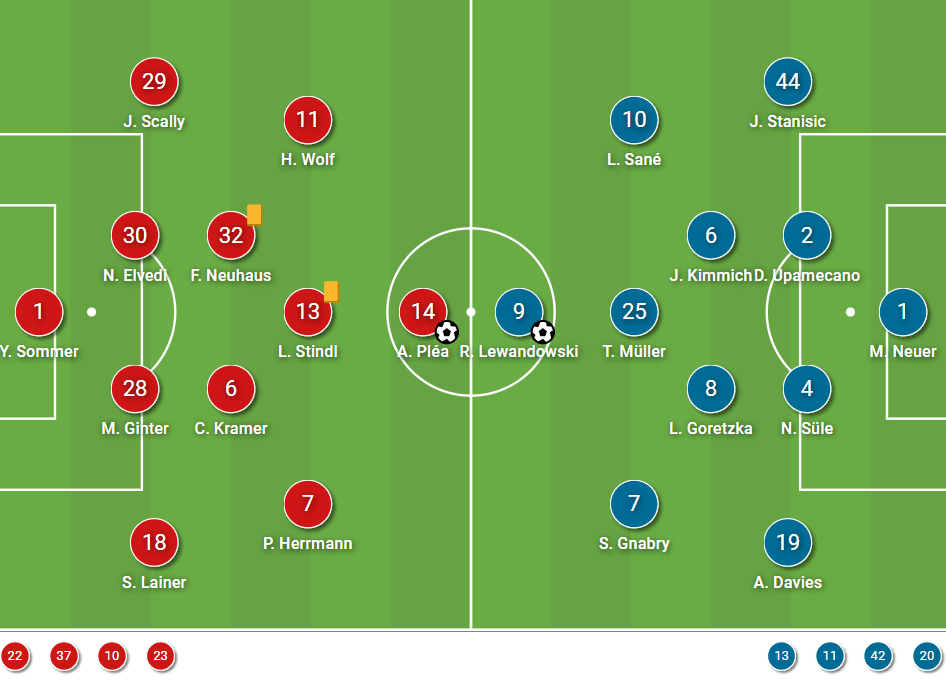
Although Marco Rose joined Borussia Dortmund this summer, he did not recruit players from Gladbach so Hütter had the key players. However, it was a brave decision to bench Marcus Thuram and Jonas Hoffmann, playing Hannes Wolf and Patrick Herrmann on the flanks as both starting wingers were not sharp in the last season. Another notable player was Joe Scally, who was only 18 from New York City FC, and played an impressive debut.
Nagelsmann had limited cards in his hands as some players were not fit to play. Therefore, Josip Stanisic got a chance to start as the right-back, while the new arrival from RB Leipzig, Dayot Upamecano, also had his debut. Nagelsmann did not make huge changes to the formation as it was the same 4-2-3-1 from Hansi Flick’s last season.
Gladbach pressing traps
As we all know, Bayern have exceptional qualities in the squad, and some are the most talented individuals in the world. In the first game of the season, Hütter did not want to risk a high line and expose too many spaces to the likes of Leroy Sané and Robert Lewandowski. Hence, his team pressed in the midfield more often with the use of traps and double-pressing.
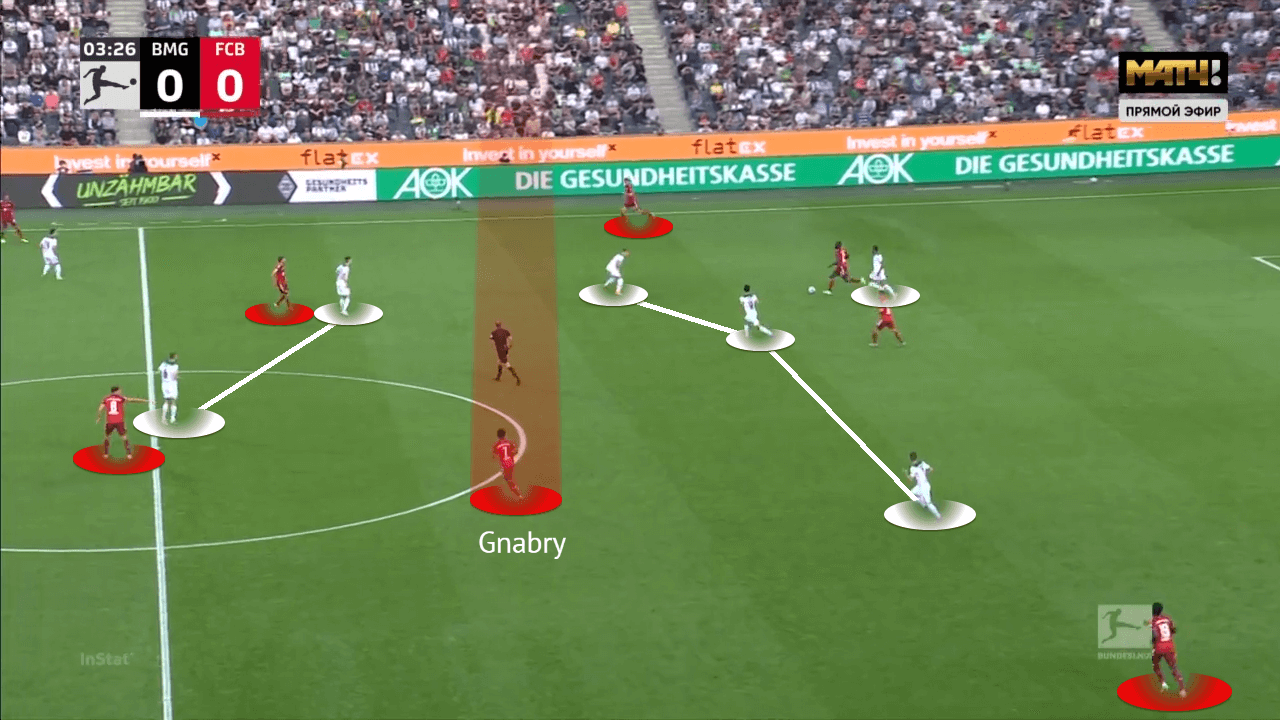
The first image will give the basic setups of both sides. Bayern began the game with a wide back four to use the width of the pitch, and a pair of defensive midfielders who would not drop. In the first phase, they relied on the individual ball-carrying of centre-backs to move the ball forward. They also had players constantly entering the half-spaces to disrupt the defence, which was Serge Gnabry in this case.
Gladbach stuck with their 4-2-3-1 formation from midblock to press, but also varied into a 4-4-2 as Lars Stindl could join Alassane Pléa occasionally. The image shows the deep positionings of both defensive midfielders as they were the keys to protect spaces in front of the back four. Therefore, the wingers should defend narrowly in the centre so Christoph Kramer and Florian Neuhaus were staying in position.
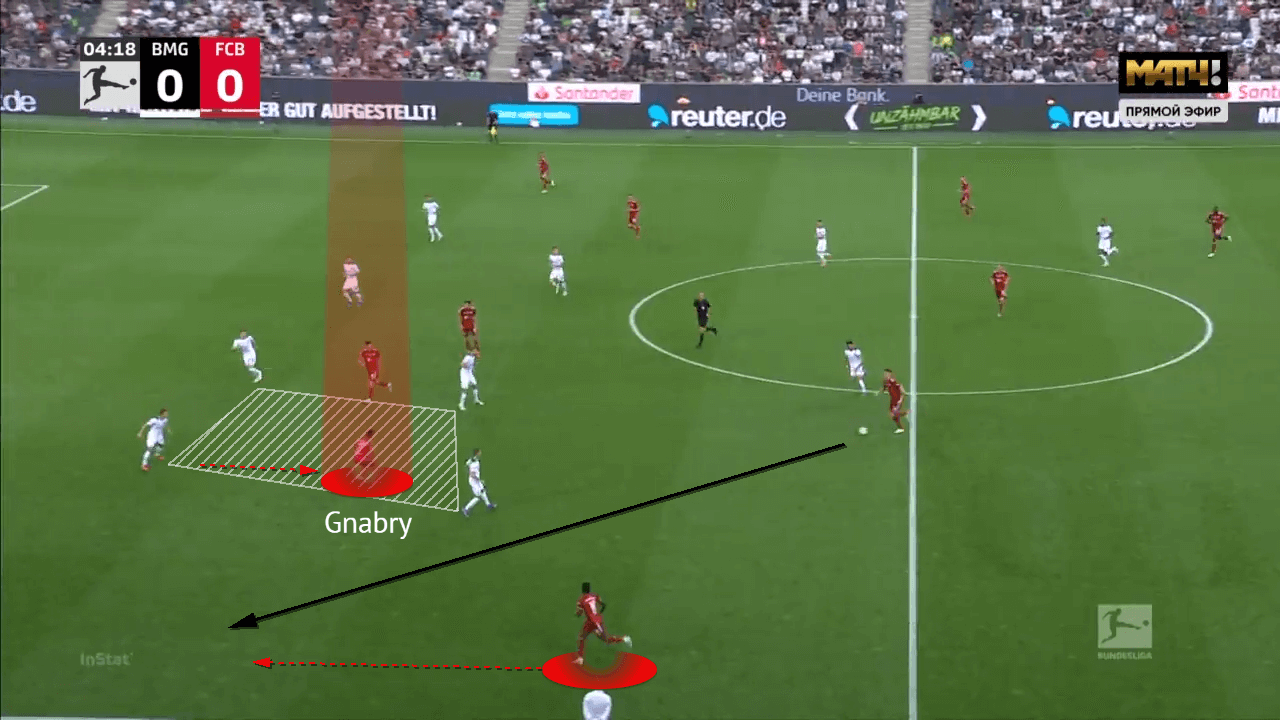
In higher areas, Bayern wisely used both half-spaces to pin the defenders, also absorbing pressure and fixing attentions to free the flanks. Gnabry was always playing in the higher left half-spaces, as we shown framed in white, within four Gladbach players. When he intentionally dropped into that space, he also fixed the right-winger’s attention, and so Herrmann was a bit narrower to limit the passing lane to half-spaces.
As a result, more wide spaces were opened for Alphonso Davies on the flank, and the Canadian left-back could have more time on the ball as there was no one tracking from behind.
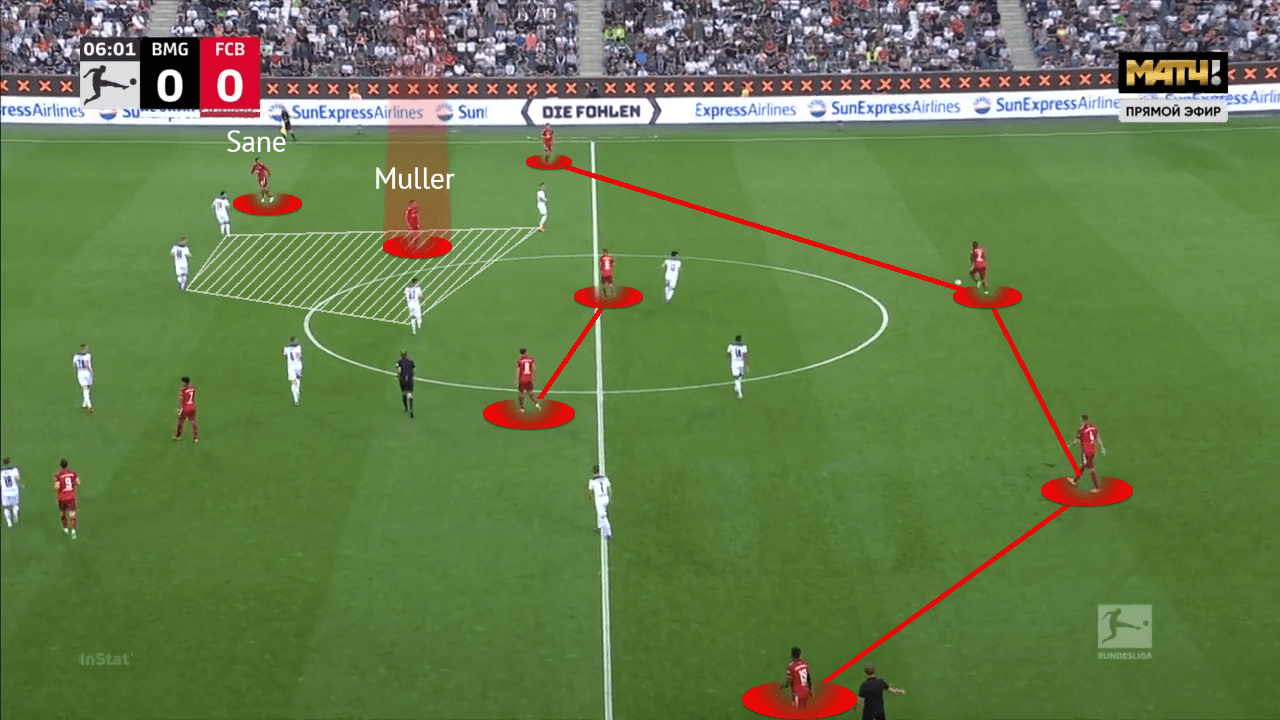
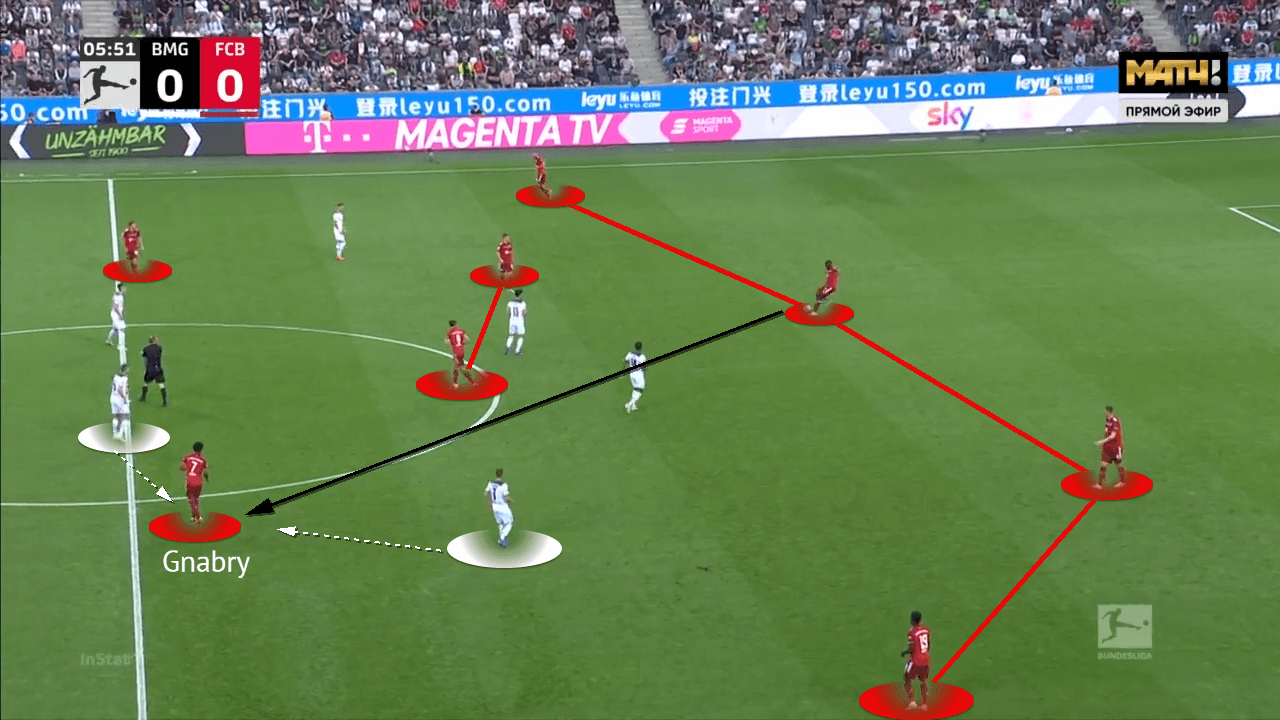
But there were too many pressing traps from Hütter’s team. Although the Austrian head coach was new to the team, this tactical concept was nothing new as Rose also implemented traps as we explained in this analysis.
The first one was a central trap. Although Gladbach sometimes might be opening a passing option for Bayern in the half-spaces, which mostly occurred when Stefan Lainer was not tightly marking Gnabry (don’t concede spaces for Davies to run behind!). They also knew Bayern’s fantastic ball-playing defender could slide the diagonal passes into that region, so they must react when this happened.
For example, the image above shows Bayern’s 4-2 shape and Gnabry was freed in the left half-spaces. However, the diagonal pass from Upamecano was a trigger to press! Since Davies was deep initially, Herrmann was also deep, and he could stay with his mates. When the pass was played, Gladbach identified it as a clear signal to press, and it was a double-press that came from two angles.
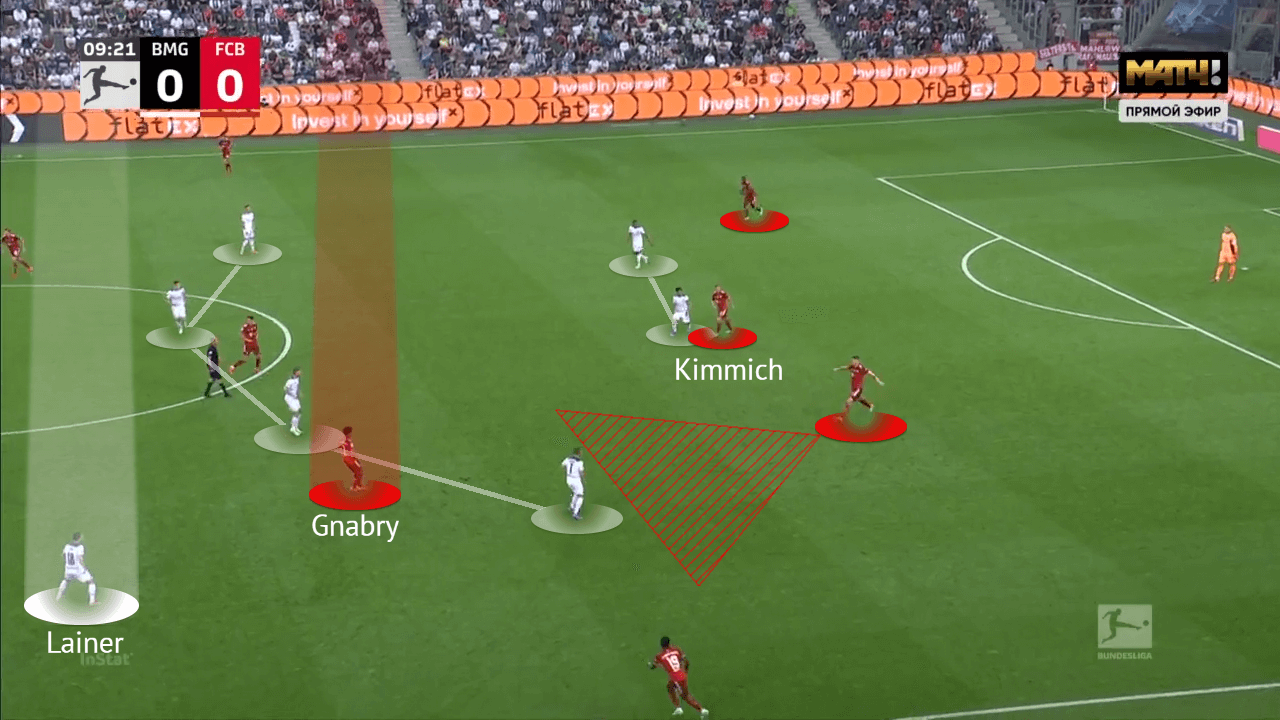
Nagelsmann was famous for his adaptiveness to his opponents, and this could also be seen from his Bayern side too. Very soon, he found out the 4-2 shape was not functioning well as the opponents were not stretched by the wide full-backs. Then, Bayern changed to a 3-1 shape with Joshua Kimmich helping the centre-backs in the build-up.
Hence, Bayern had three men in the first line. Even Gladbach put Stindl with Pléa high, the numerical advantage was inevitable. The above screenshots showed the 3v2 overload, which allowed Niklas Süle to carry the ball forward.
Again, Gnabry appeared in the half-spaces and behind Herrmann. He was free without the tight marking from Lainer, but Süle also read the trap and he did not play into Gnabry, avoiding the scenario from the previous example.
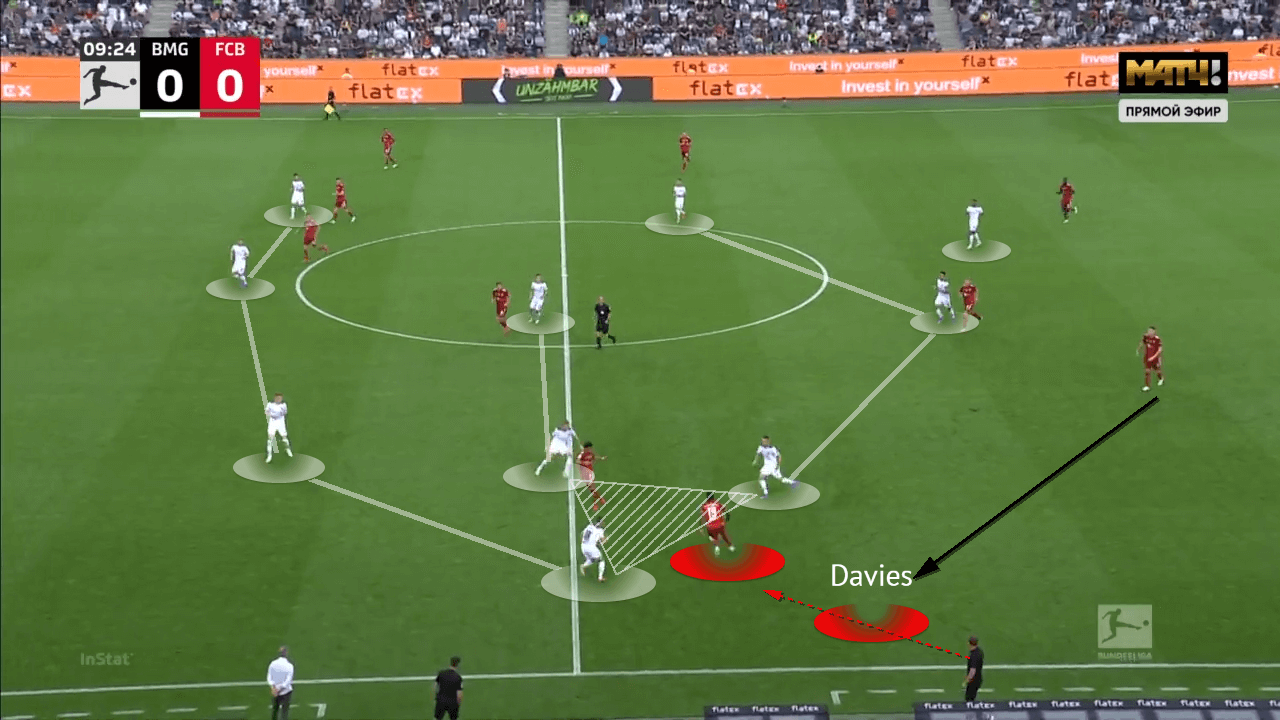
Instead, Süle found Davies in deep with a diagonal pass. But there were too many Gladbach pressing traps. When Lainer came out to block the spaces in front of Davies, the Canadian international just dribbled inward diagonally and towards Gnabry, right into the net of the oppositions!
As we have shown, just three seconds later, Davies entered a region with three Gladbach players the same space together, it was a triple-press! It was another good example of the pressing traps in half-spaces, and how the hosts recovered possession again.
Adaptive Bayern
As we suggested above, Bayern were very adaptive. Against this tough Gladbach side, they have been searching for solutions in the entire game. Switching from a 4-2 shape to a 3-1 was the first one, but there were more changes as the game continued.
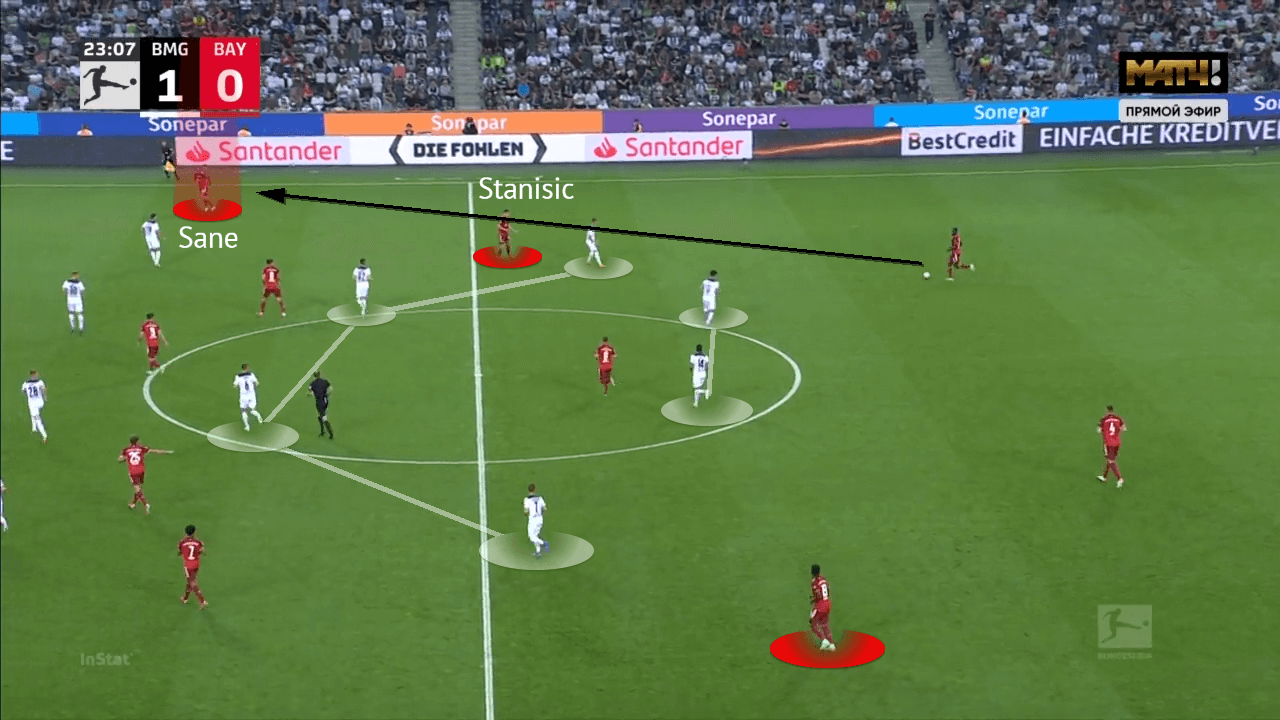
Another early adjustment of Nagelsmann was to instruct Stanisic going into the half-spaces, so the 4-2 shape was the past as full-backs were no longer holding the width constantly. Also, Leon Goretzka could go higher to exploit spaces between the lines, but Bayern were still mainly attacking from the flanks.
From this image, you can see the right-back was narrower this time. Now, the passing lane from centre-back to winger was opened as Sané was opening on the wide right. Upamecano very easily found the German international.
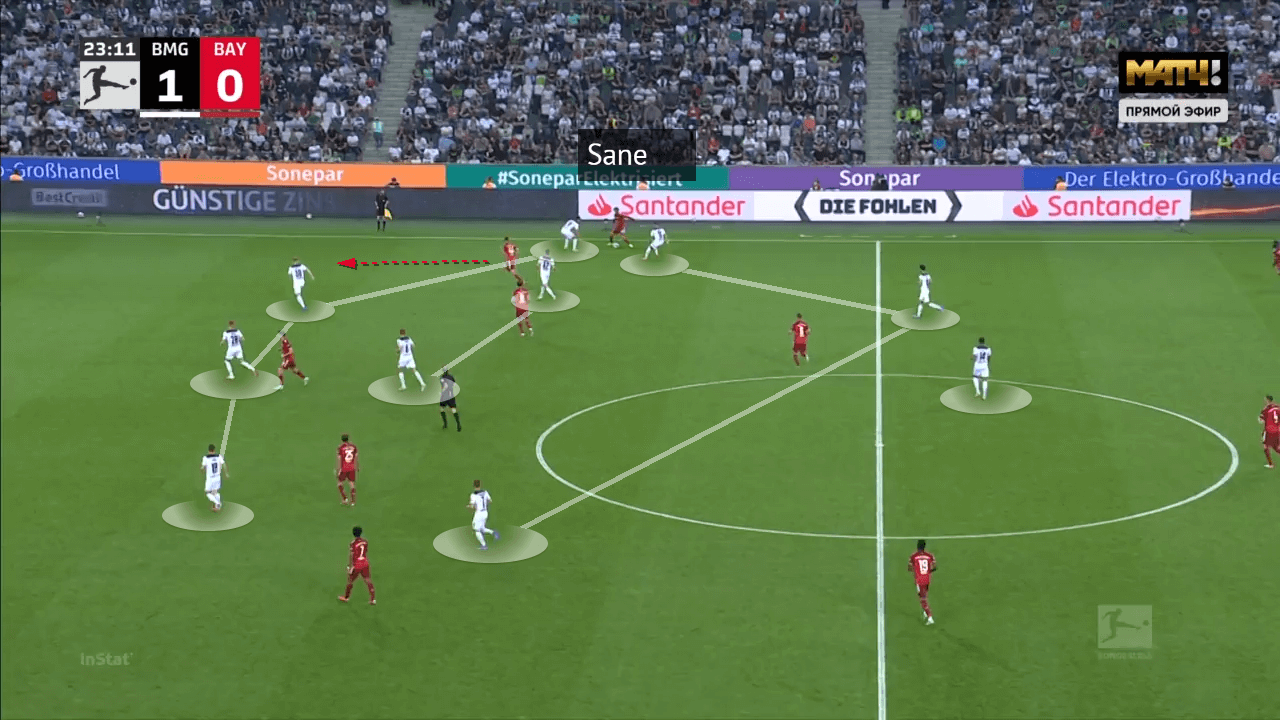
But this was a trap too! Although Sané was found, the pass also invited the pressure from Scally, who confronted the former Manchester City man diagonally. The angle of the press was great as it blocked the way to Sané’s stronger side, but he was not the only pressing player.
The disciplined Gladbch wingers should deserve some praises as well, since they were never drawn away by the oppositions, there were chances to double-press on the right. And this was the double-press, as Wolf was very close to Sané from a high position, Sané could not check the ball back to his left foot and start dribbling, it was very difficult to escape.
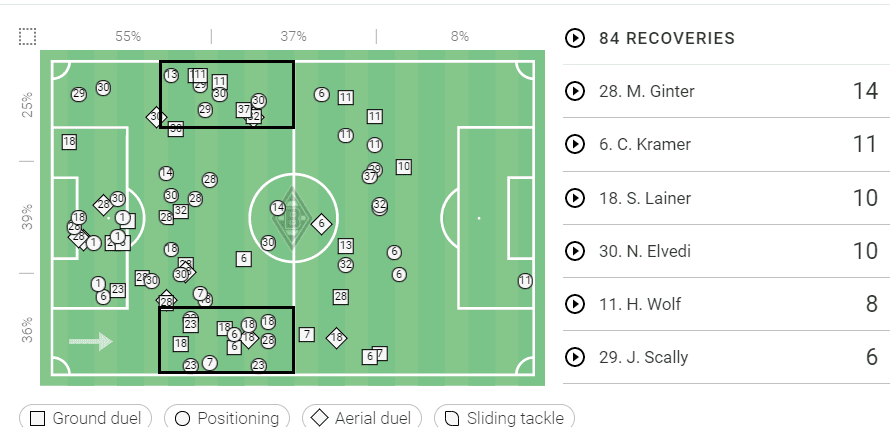
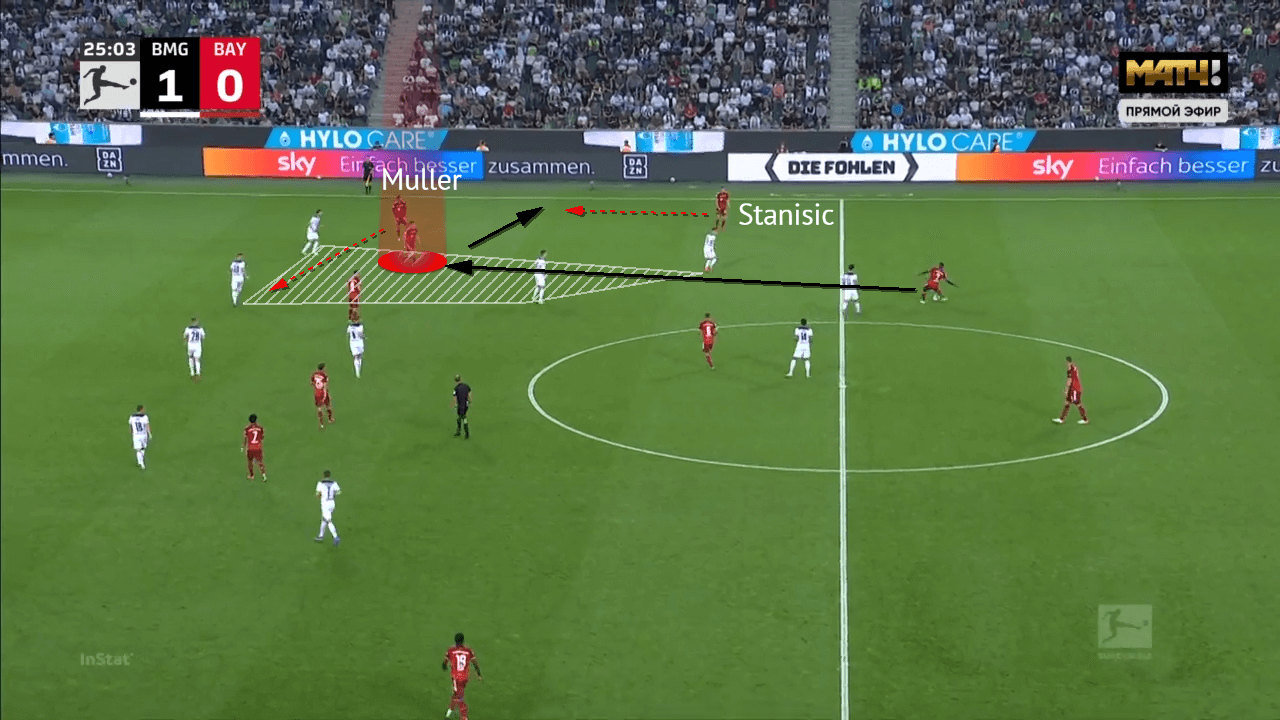
But Bayern were too clever, they took around half an hour to adapt, and there were more chances created. Nagelsmann did not abandon the idea of dominating half-spaces, but just doing things a bit differently.
Instead of playing diagonals to the opposite half-spaces or to the wide right, on the above occasion, Upamecano played vertically into Thomas Müller. Simultaneously, Sané moved laterally inward to keep the left-back busy, so Bayern could quickly advance the ball to Stanisic through a third-man play. And this would not trigger the side trap as players were moved away from the touchline before passing.
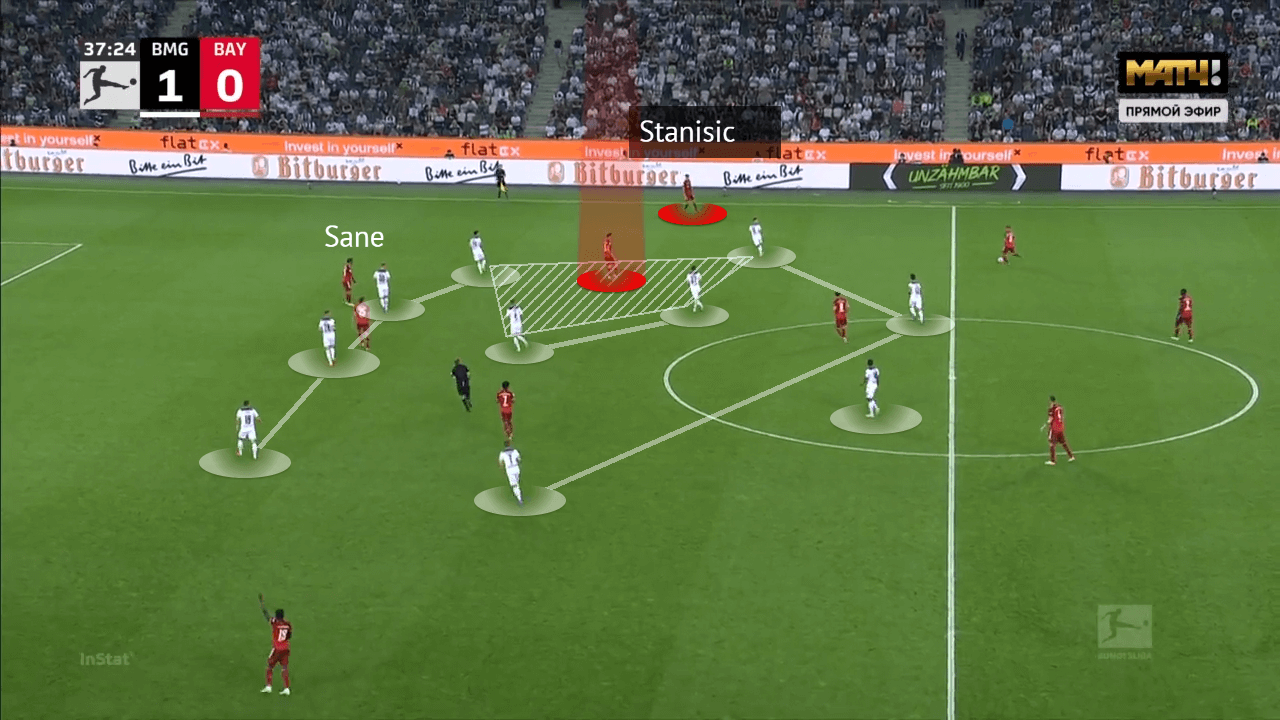
Another example here. Müller, again occupying that pocket of spaces between four players, while Stanisic was higher to receive behind of Wolf. As Sané drifted inward to bring away the left-back, there was no chance to double-press and Bayern could attack from the flank.
But Stanisic’s limited 1v1 skills, crossing, pace, and dribbling ability hindered Bayern’s full attacking potentials, more clear-cut opportunities should be created from this flank.
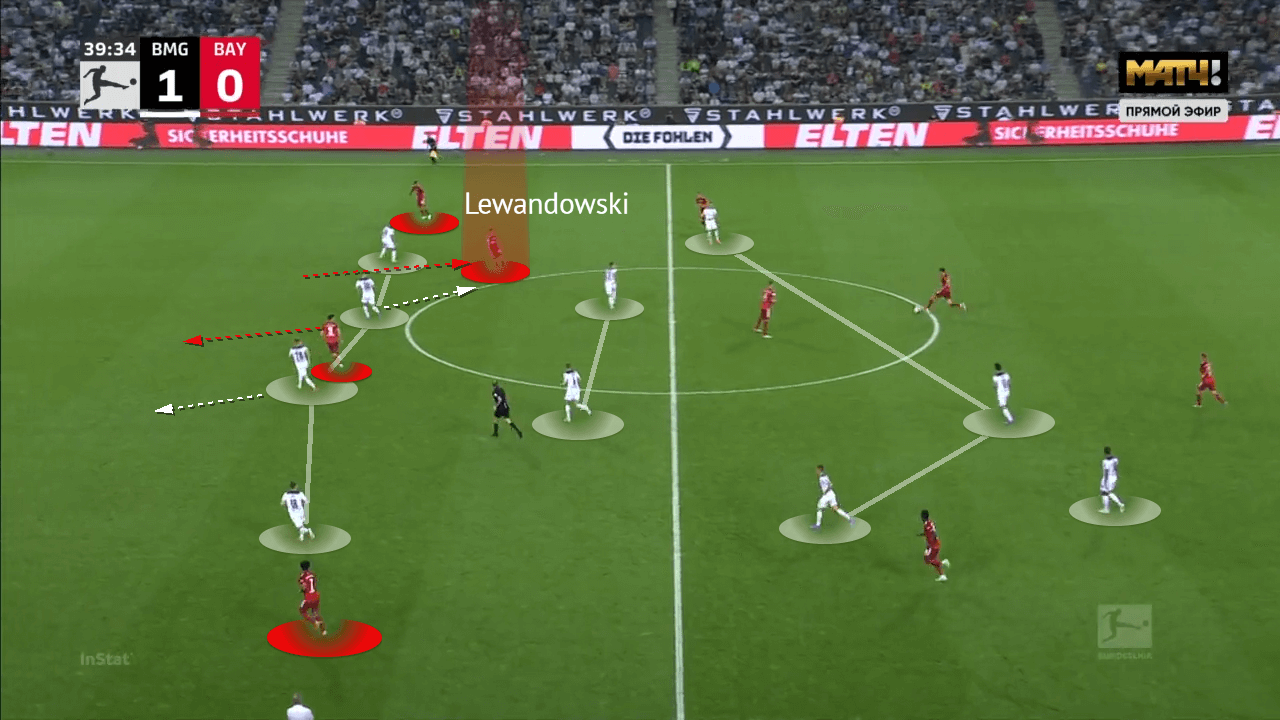
The last example of the section shows Lewandowski in the half-spaces. The Poland international was playing in that zone more often as Sané was higher to push the defence deeper.
When Lewandowski dropped, the centre-back was not following initially as Sané was going forward, the gap must not be opened. After Upamecano cleverly picked Lewandowski, it was a 4v4 against the backline: separations and isolations were easily created as the others kept running forward. Müller was almost picked by a clever pass in a situation against Matthias Ginter 1v1.
Flexible Gladbach
Gladbach had limited possession in the game, and they were not taking excessive risks in the build-up as the opponents were the champion of Germany. Hütter used some smart tactics to help the team advancing the forward in this game.
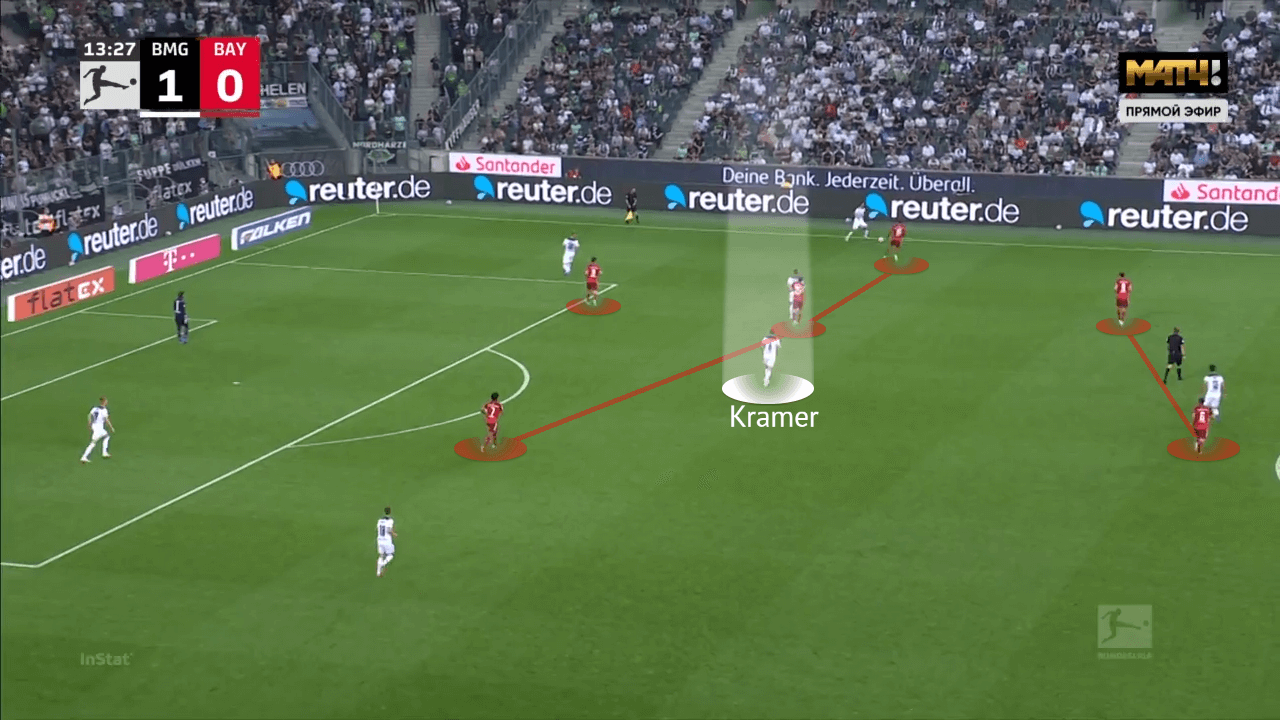
In general, Bayern kept the 4-2-3-1 pressing shape with Müller joining Lewandowski occasionally, which would be a 4-4-2. However, Gladbach adapted to the shape pretty well and found the leeway out by exploiting Sané’s poor defending. There were some interesting situations that could be analyzed.
In the above image, Bayern only marked one Gladbach pivot as Kramer paralleled with Neuhaus, it was unnecessary to mark him as he was under Müller’s shadow already. With Lewandowski pressing the centre-back, Gnabry a bit higher to prevent the switch, Bayern midfielders could stay a bit deeper to mark Stindl.
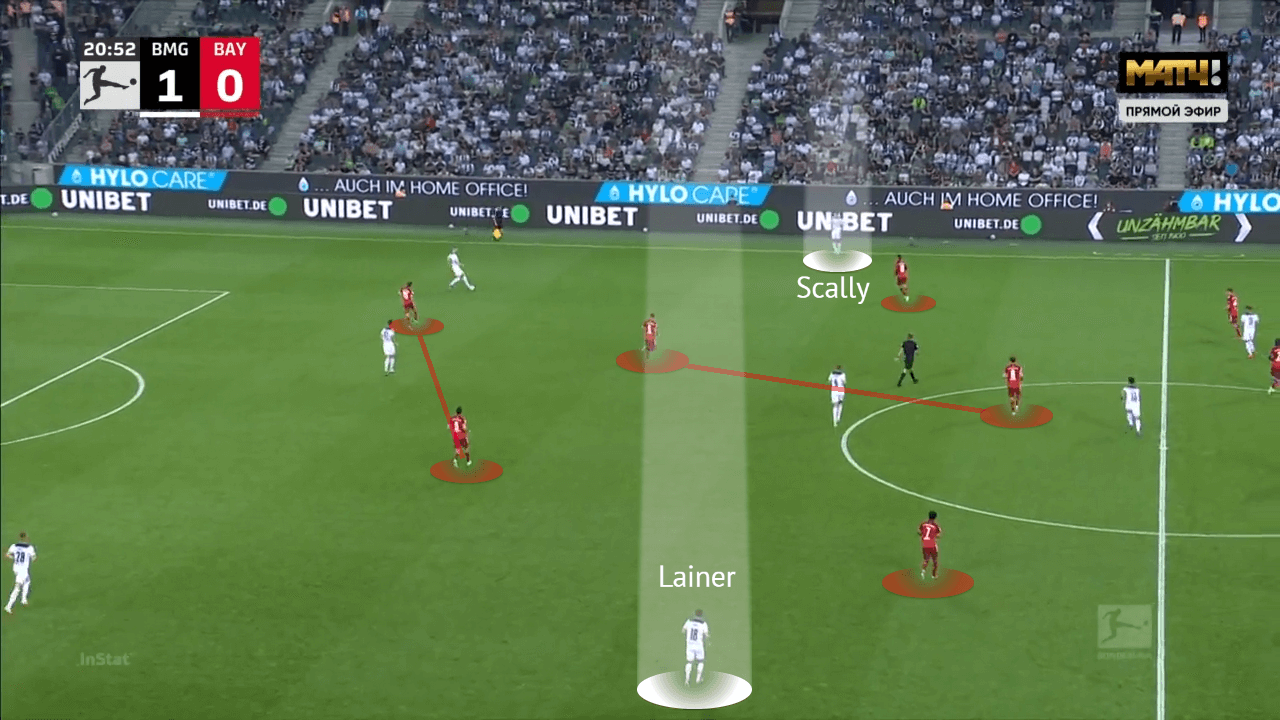
It was a different scenario from the previous one in this frame. Gladbach full-backs were a bit higher and closer to the second third, and they kept the Bayern wingers deep and away from the strikers. As Neuhaus dropped deeper and pulled Kimmich out of position, Sané was isolated on the far-side without a cover from midfield.
Gladbach’s 18-year-old left-back Scally handed an impressive performance by bravely knocking the ball past Sané a few times. These 1v1 duels were always pivotal to the start of the attacks, if Gladbach won, they would advance into the second phase.
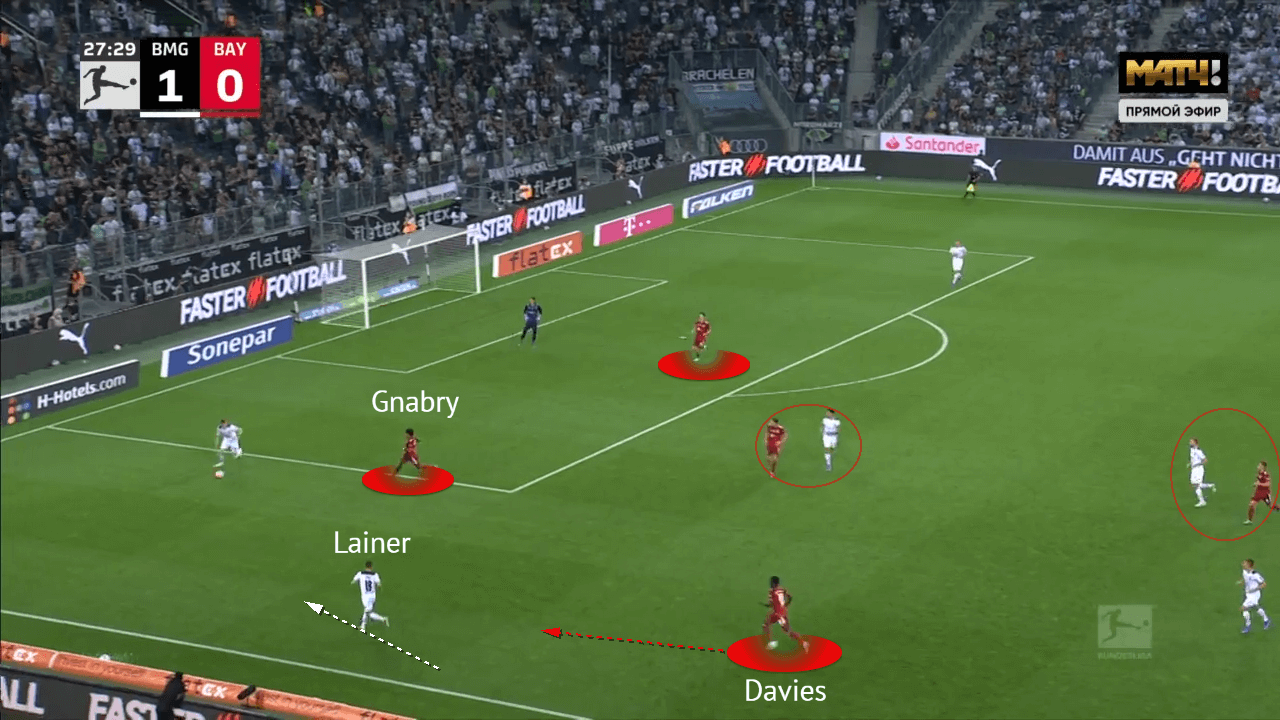
If Bayern were pressing high, they often had the full-backs coming out to close the wide spaces. In the 4-2-3-1, the wingers were initially staying inside to block the half-spaces, and pressing the centre-backs vertically. Without the high full-backs, the Gladbach full-backs would be unmarked.
In the above image, Gnabry pressed the centre-back vertically, and Bayern set a side trap by baiting the pass to Lainer. When the Austrian international was dropping with a closed body shape, Davies was already lurking behind and ready for a press. On some occasions, Bayern won the ball back through the trap, but Gladbach managed to escape by a direct method in this one.
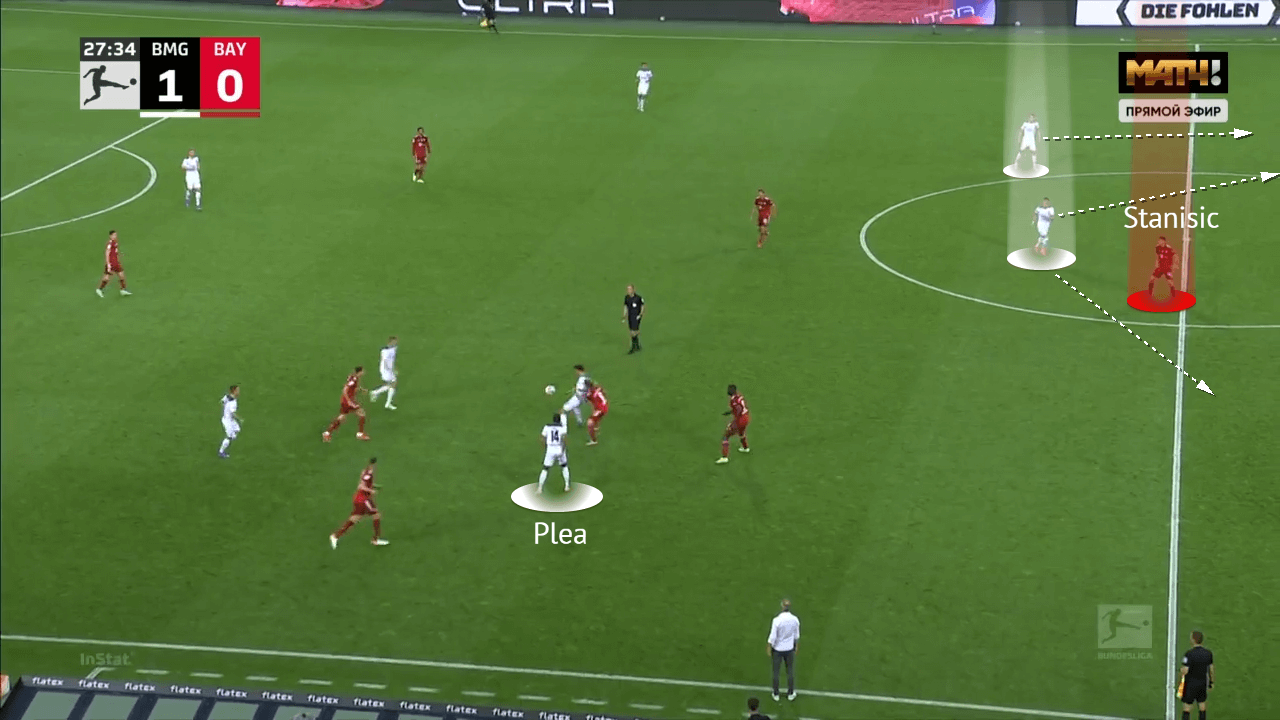
As we’ve said, Hütter’s team would not risk playing short passes when the oppositions were pressing with great intensity. Hence, Gladbach also went long as a solution to the press. That was the reason of Pléa starting over Thuram. The Gladbach #14 was better in the air, and he could head the ball in front of defenders to link teammates in the midfield.
After Gladbach went long, Pléa already won the first duel in the next image. His presence as the first target would also draw the Bayern centre-backs out of positions, leaving huge spaces behind the incomplete high line. If they managed to retrieve the second ball, the far-side players would be running behind and they were too many for Stanisic to handle all.
Second half developments
The game was liked a game of chess as both managers were trying their best to provide solutions and asking the opponent another question. In the second half, there were more transitions and spaces to attack. Structurally, Bayern also changed a bit to exploit the right flank differently.
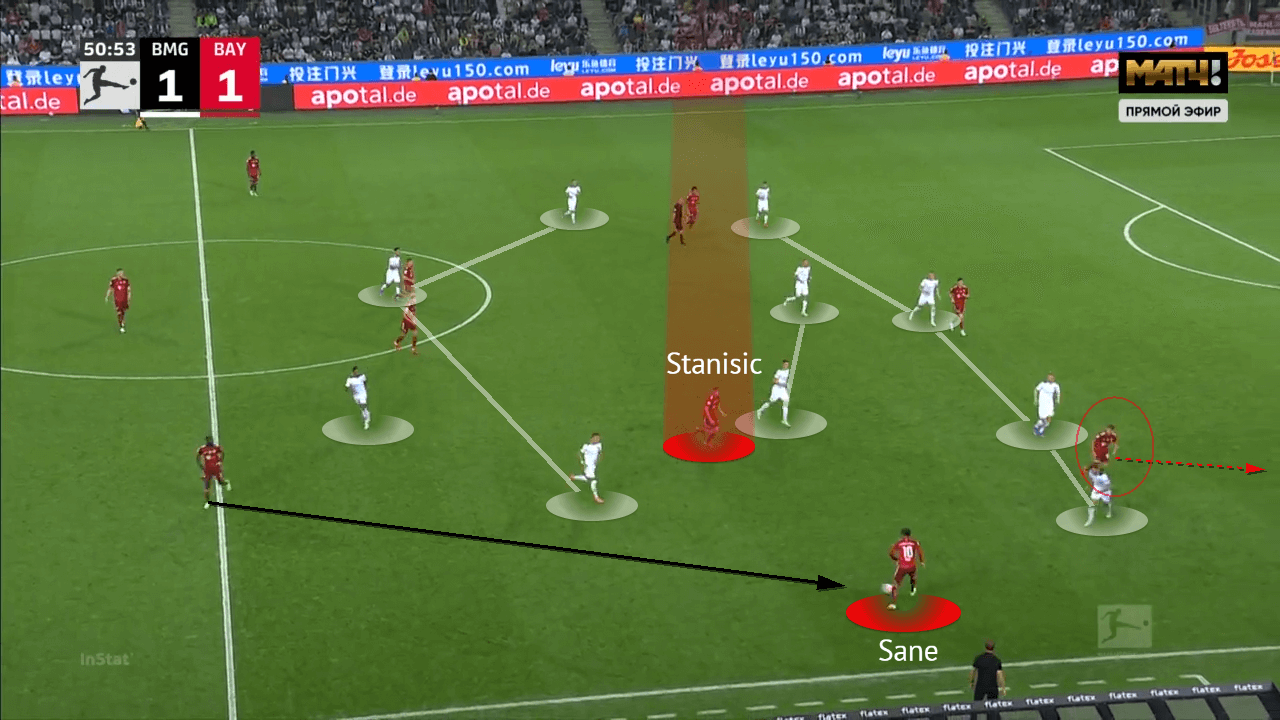
In the second phase, the likes of Kimmich and Goretzka were moving to the half-spaces to form temporary back three more often. Apart from that, we also pointed out the narrow positioning of Stanisic. Nevertheless, Nagelsmann wanted to eliminate the pressing trap and instructed the youngster to go further inward.
In the above screenshot shots Stanisic was even closer to the centre, and he drew the left-winger very narrowly in half-spaces as well. So, the passing channel from Upamecano to Sané was opened, but Wolf could not shift to prevent Sané from checking the ball to his stronger foot. Meanwhile, you could see the forward movement that searched depths behind the left-back, so Scally was a bit conservative, and Sané had the spaces to play.
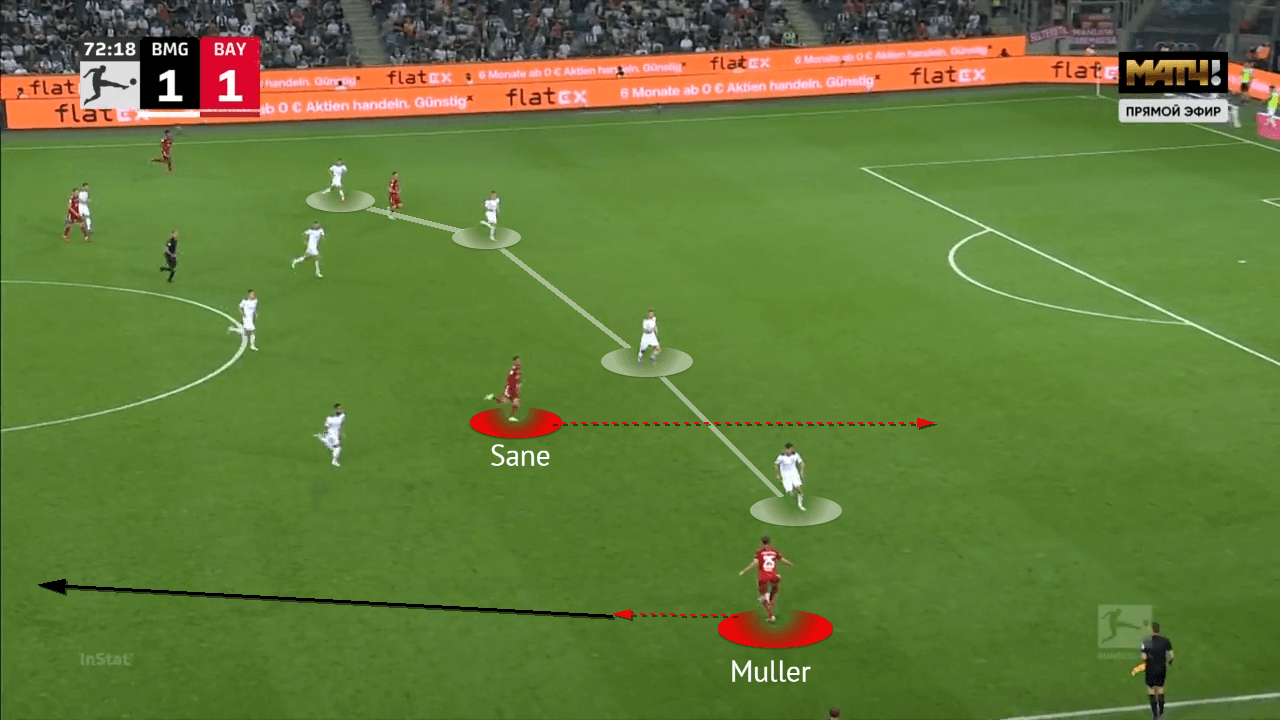
Nagelsmann also had another solution, which was moving Müller to the right flank and kept Sané in the centre. This would provoke another question to Scally, who was used to face a left-footed attacker in this game, now the task was to press a right-footed attacker. When the gap was opened, as suggested in the above image, Sané should attack the channels to receive behind.
But Bayern did not gain many advantages. Scally adapted to the changes very well, and his pressing was often forcing Müller to check the ball on his weaker left foot. Therefore, Müller was uncomfortable when he received it, and Bayern lost the rhythm of play when that happened.
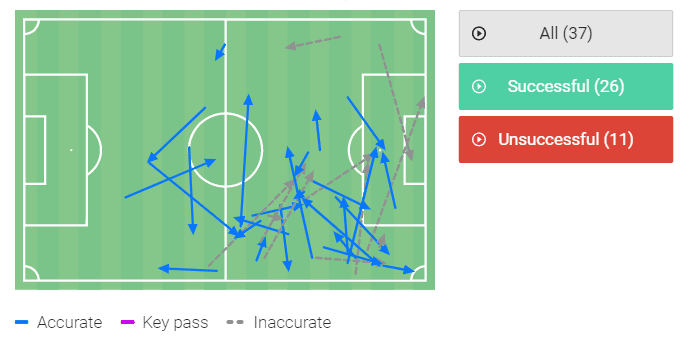
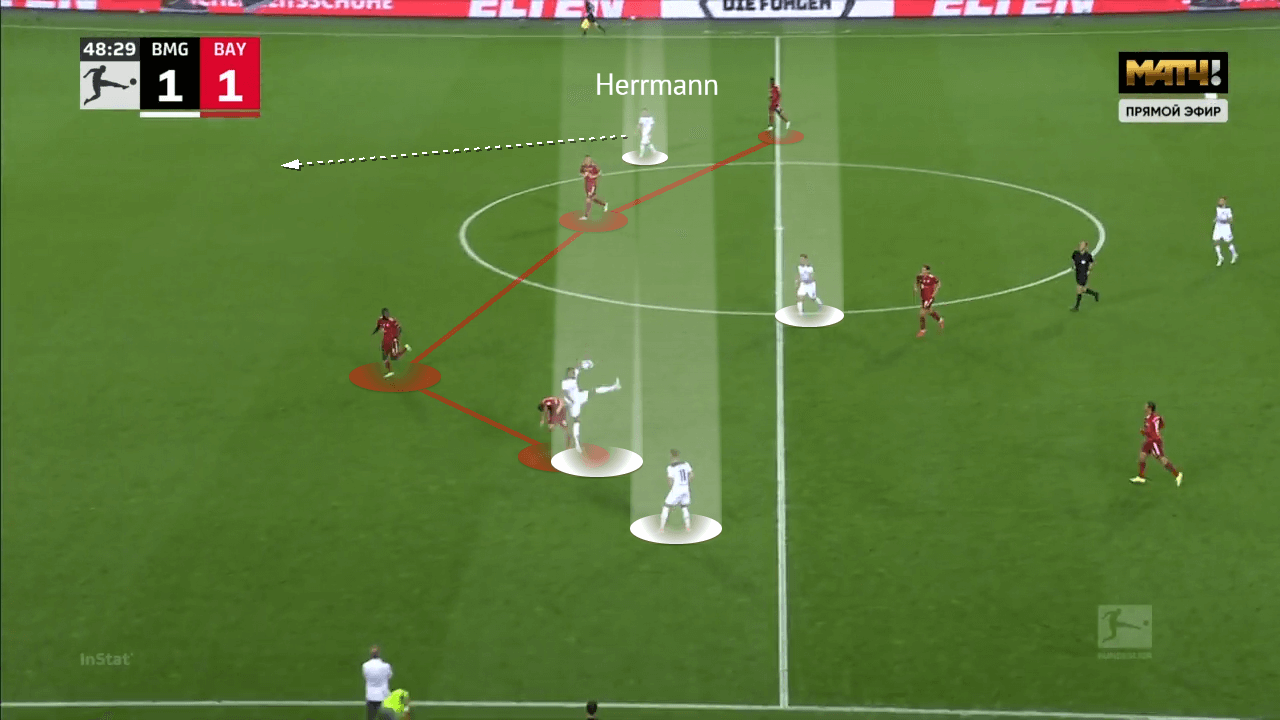
Gladbach dipped a bit when Bayern dominated the game, they could merely rely on the high front four to exploit spaces behind the high line. The above image shows a favourable 4v4 situation after a long ball. When Hütter’s men were attacking the left side, they knew Bayern must be shifting and the far side would be opened. Therefore, Herrmann was always high and ready to make runs behind, exploiting the blindside of Süle and the poor body shape of Davies.
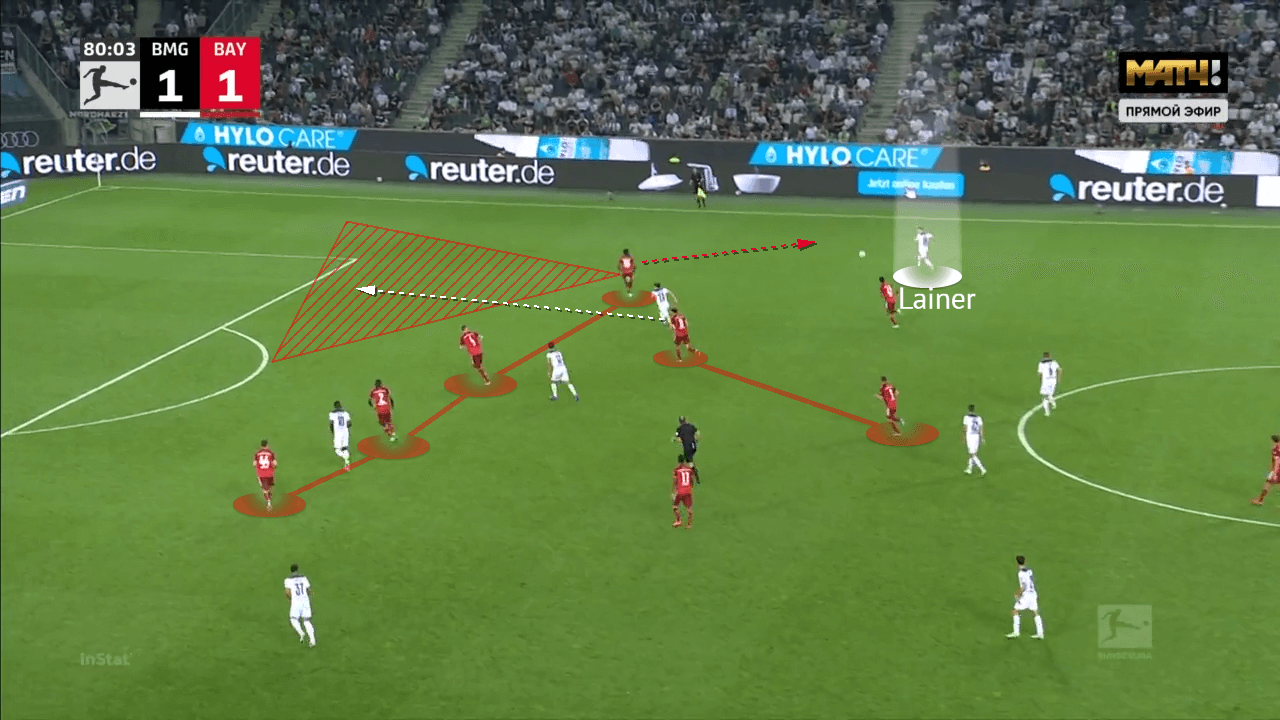
In the closing stages of the game, we had some surprises as Gladbach restored energy after introducing the likes of Thuram and Hoffmann. Also, Lainer looked energetic when coming forward from deep, and he always formed a 2v1 overload on Davies with the right-winger.
Bayern suffered when Gladbach attacked Davies’ side. As we showed in the image above, when Davies pressed Lainer, spaces behind was exposed and exploited by Hoffmann’s forward runs. Their midfielders were not tracking tightly because of the initial attachment on Gadbach midfielders, so Gladbach managed to get behind the defenders, delivering dangerous crosses which were almost converted into goals.
Final remarks
“It was a great opening game, but both teams have room for improvement.” – Hütter
It was a fair comment from Hütter, and Nagelsmann also pointed out something similar in the post-match conference. The game was an exciting one as the first one of the season, it was close, both teams had chances to score another goal but that did not happen. There were many positives to take but the head coaches also knew what could be improved in the future. For Bayern, the positional structure must be improved to instore fluidity in the attacks, while Gladbach still needed more time to grasp the key tactical principles of Hütter. We can be expecting more from these two teams.




Comments